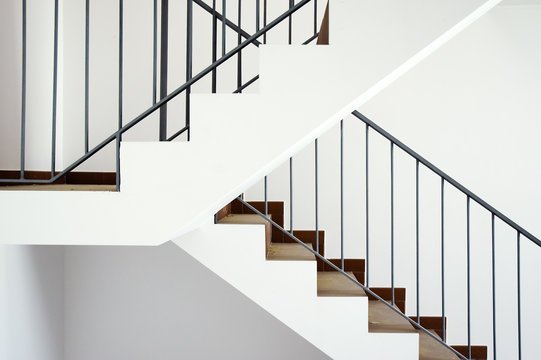Stairs are one of the most important parts of a building’s architecture because they serve both functional and aesthetic purposes. Most people use stairs every day, but not everyone knows all the technical terms that go along with them. A “flight of stairs” is one of the most common terms.
- What is a set of stairs?
- Important Things to Know About a Flight of Stairs:
- Staircase vs. Flight of Stairs
- Different kinds of stairs
- The Importance of Stairs in Architecture
- Things to think about when designing flights of stairs
- Common Examples of Flights of Stair
- FAQS : Normally People Asked Questions
- Conclusion
But what does it mean? What makes a flight of stairs different from a staircase? And why is it important for building and designing?
In this article, we’ll explain what a flight of stairs is, how it’s built, the different types, what to think about when designing one, and how it’s used in modern architecture.
What is a set of stairs?
A flight of stairs is a set of steps that goes from one floor or level to another without stopping. In short, it is a series of steps that go all the way up and down between two landings.
For instance:
There is one flight of stairs if there are 12 steps going straight up from the ground floor to the first floor.
There would be two flights of stairs if there is a landing (a place to rest) in between and then another set of steps.
Important Things to Know About a Flight of Stairs:
Steps that keep going without stopping
Usually between 8 and 16 steps for comfort and safety
Links two levels or heights
Often surrounded by railings or balustrades for safety
Staircase vs. Flight of Stairs
People often use the words “staircase” and “flight of stairs” to mean the same thing, but they are not the same.
Staircase: This word means the whole thing, including all the flights, landings, and railings.
A flight of stairs is a single, continuous run of steps that goes from one landing to the next.
You could say that a staircase has more than one flight of stairs, depending on how the building is built.
Different kinds of stairs
Depending on the building’s needs and the space available, stairs can be built in different ways. Here are some of the most common types:
1. Straight Flight of Stairs
- A straightforward, unbroken series of steps.
- Most common in homes.
- Simple to build and not too expensive.
2. Flight in a L shape
- Has a landing that makes the stairs turn 90 degrees.
- Good for homes with little space.
- Safer because the landing makes it less likely that someone will fall down the whole staircase.
3. U-Shaped Flight
- There are two parallel flights that are connected by a landing.
- Used a lot in commercial buildings because they save space.
- Gives users places to rest.
4. Flight in a spiral or circle
Made to look like a spiral or circle.
Small and takes up little space.
Adds a decorative touch to modern buildings.
5. Flight Split
- It starts as a single flight but splits into two at the landing.
- Commonly seen in big places like hotels and auditoriums.
- Creates a grand and elegant entrance.
- Ideal Number of Steps in a Flight of Stairs
Studies of ergonomics and building codes say that a comfortable flight of stairs usually has between 8 and 16 steps. Long flights without stops can be tiring and dangerous.
Some general rules are:
The height of the step (riser) is 6 to 8 inches.
The depth of the step (tread) is 10 to 12 inches.
Length of flight: Should not be longer than 12 to 16 steps without landing
The Importance of Stairs in Architecture
Stairs are very important for both function and design. Here’s why they are important:
Accessibility: Make sure people can move up and down inside a building.
Safety: Well planned flights make sure that users are comfortable and accidents are less likely to happen.
Aesthetics: In architectural design, stairs are often the main focus.
Efficiency: Well-planned flights save space and make buildings flow better.
Compliance: Necessary for following safety rules and building codes.
Things to think about when designing flights of stairs
When designing a flight of stairs, architects and builders consider:
Space Availability: Spiral flights save space, while straight flights need more linear space.
User Comfort : Proper riser and tread dimensions prevent strain and accidents.
Safety Rules: You must have handrails, balustrades, and landings to be safe.
Aesthetic Appeal: The choice of material (wood, concrete, steel, glass) adds style.
Functionality: The design choices are affected by the intended use (residential vs. commercial).
Common Examples of Flights of Stair
A flight of stairs is a straight run of steps that goes from the living room to the first floor.
In shopping malls, landings connect multiple flights of stairs to make them easier to get to.
Modern apartments with spiral staircases are stylish examples of small staircases.
FAQS : Normally People Asked Questions
1. How many steps are there in a flight of stairs?
A flight usually has 8 to 16 steps, but this can change based on building codes and design.
2. Is a flight of stairs the same as a staircase?
No. A flight of stairs is one long run of steps, while a staircase is made up of all the flights, landings, and railings.
3. Is it possible for a flight of stairs to have a landing?
No. A landing, by definition, divides a flight into two separate flights.
4. What is the most steps that can be in a flight of stairs?
For safety and comfort, building codes usually say that there should be no more than 16 steps without a landing.
5. What is the point of having stairs in a design?
They make sure that people can move safely up and down, follow building codes, and make buildings look better.
Conclusion
A flight of stairs is a basic part of a building’s design. It is a series of steps that connect two levels without any breaks. It may look simple, but the way it is built has a direct effect on how safe, comfortable, and beautiful a building is.
Stairs can be straight, L-shaped, spiral, or split, and they are both useful and beautiful parts of modern architecture. Knowing how they work and why they’re important helps both homeowners and builders, and it also makes sure that safety rules are followed.




